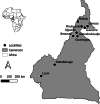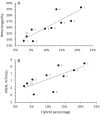Hybridization increases genetic diversity in Schistosoma haematobium populations infecting humans in Cameroon
- PMID: 35346375
- PMCID: PMC8962594
- DOI: 10.1186/s40249-022-00958-0
Hybridization increases genetic diversity in Schistosoma haematobium populations infecting humans in Cameroon
Abstract
Background: Hybrids between Schistosoma haematobium (Sh) and S. bovis (Sb) have been found in several African countries as well as in Europe. Since the consequences of this hybridization are still unknown, this study aims to verify the presence of such hybrids in Cameroonian humans, to describe the structure of S. haematobium populations on a large geographic scale, and to examine the impact of these hybrids on genetic diversity and structure of these populations.
Methods: From January to April 2019, urine from infected children was collected in ten geographically distinct populations. Miracidia were collected from eggs in this urine. To detect the presence of hybrids among these miracidia we genotyped both Cox1 (RD-PCR) and ITS2 gene (PCR-RFLP). Population genetic diversity and structure was assessed by genotyping each miracidium with a panel of 14 microsatellite markers. Gene diversity was measured using both heterozygosity and allelic richness indexes, and genetic structure was analyzed using paired Fst, PCA and Bayesian approaches.
Results: Of the 1327 miracidia studied, 88.7% were identified as pure genotypes of S. haematobium (Sh_Sh/Sh) while the remaining 11.3% were hybrids (7.0% with Sh_Sh/Sb, 3.7% with Sb_Sb/Sh and 0.4% with Sb_Sh/Sb). No miracidium has been identified as a pure genotype of S. bovis. Allelic richness ranged from 5.55 (Loum population) to 7.73 (Matta-Barrage) and differed significantly between populations. Mean heterozygosity ranged from 53.7% (Loum) to 59% (Matta Barrage) with no significant difference. The overall genetic differentiation inferred either by a principal component analysis or by the Bayesian approach shows a partial structure. Southern populations (Loum and Matta Barrage) were clearly separated from other localities but genetic differentiation between northern localities was limited, certainly due to the geographic proximity between these sites.
Conclusions: Hybrids between S. haematobium and S. bovis were identified in 11.3% of miracidia that hatched from eggs present in the urine of Cameroonian schoolchildren. The percentages of these hybrids are correlated with the genetic diversity of the parasite, indicating that hybridization increases genetic diversity in our sampling sites. Hybridization is therefore a major biological process that shapes the genetic diversity of S. haematobium.
Keywords: Cameroon; Genetic diversity; Hybridization; Miracidium; Schistosoma bovis; Schistosoma haematobium.
© 2022. The Author(s).
Conflict of interest statement
The authors declare that they have no competing interests.
Figures



Similar articles
-
Population genetic structure of Schistosoma haematobium and Schistosoma haematobium × Schistosoma bovis hybrids among school-aged children in Côte d'Ivoire.Parasite. 2022;29:23. doi: 10.1051/parasite/2022023. Epub 2022 May 3. Parasite. 2022. PMID: 35522066 Free PMC article.
-
Population Genetic Structure and Hybridization of Schistosoma haematobium in Nigeria.Pathogens. 2022 Mar 31;11(4):425. doi: 10.3390/pathogens11040425. Pathogens. 2022. PMID: 35456103 Free PMC article.
-
High prevalence of Schistosoma haematobium × Schistosoma bovis hybrids in schoolchildren in Côte d'Ivoire.Parasitology. 2020 Mar;147(3):287-294. doi: 10.1017/S0031182019001549. Epub 2019 Nov 21. Parasitology. 2020. PMID: 31727202 Free PMC article.
-
Natural Intra- and Interclade Human Hybrid Schistosomes in Africa with Considerations on Prevention through Vaccination.Microorganisms. 2021 Jul 8;9(7):1465. doi: 10.3390/microorganisms9071465. Microorganisms. 2021. PMID: 34361901 Free PMC article. Review.
-
[Schistosoma species in Senegal with special reference to the biology, epidemiology and pathology of Schistosoma curassoni Brumpt, 1931].Verh K Acad Geneeskd Belg. 1990;52(1):31-68. Verh K Acad Geneeskd Belg. 1990. PMID: 2191509 Review. Dutch.
Cited by
-
Development of an automated artificial intelligence-based system for urogenital schistosomiasis diagnosis using digital image analysis techniques and a robotized microscope.PLoS Negl Trop Dis. 2024 Nov 5;18(11):e0012614. doi: 10.1371/journal.pntd.0012614. eCollection 2024 Nov. PLoS Negl Trop Dis. 2024. PMID: 39499735 Free PMC article.
-
A duplex tetra-primer ARMS-PCR assay to discriminate three species of the Schistosoma haematobium group: Schistosoma curassoni, S. bovis, S. haematobium and their hybrids.Parasit Vectors. 2023 Apr 7;16(1):121. doi: 10.1186/s13071-023-05754-9. Parasit Vectors. 2023. PMID: 37029440 Free PMC article.
-
Population genetic structure of Schistosoma haematobium and Schistosoma haematobium × Schistosoma bovis hybrids among school-aged children in Côte d'Ivoire.Parasite. 2022;29:23. doi: 10.1051/parasite/2022023. Epub 2022 May 3. Parasite. 2022. PMID: 35522066 Free PMC article.
-
Genetic profiles of Schistosoma haematobium parasites from Malian transmission hotspot areas.Parasit Vectors. 2023 Aug 4;16(1):263. doi: 10.1186/s13071-023-05860-8. Parasit Vectors. 2023. PMID: 37542265 Free PMC article.
-
Molecular Detection of Urogenital Schistosomiasis in Community Level in Semi-Rural Areas in South-East Gabon.Diagnostics (Basel). 2025 Apr 22;15(9):1052. doi: 10.3390/diagnostics15091052. Diagnostics (Basel). 2025. PMID: 40361870 Free PMC article.
References
-
- Harrison RG. Hybrid zones: windows on evolutionary process. In: Futuyma D, Antonovics J, editors. Oxford surveys in evolutionary biology. New York: Oxford University Press; 1990. pp. 69–128.
-
- Arnold ML. Natural hybridization as an evolutionary process. Annu Rev Ecol Syst. 1992;23:237–261. doi: 10.1146/annurev.es.23.110192.001321. - DOI
MeSH terms
LinkOut - more resources
Full Text Sources
Miscellaneous

